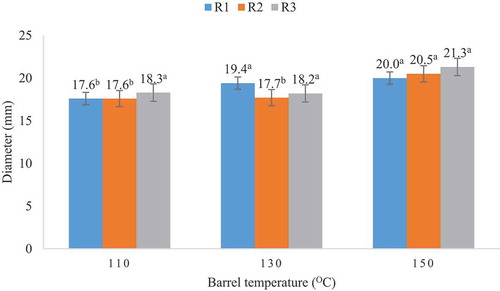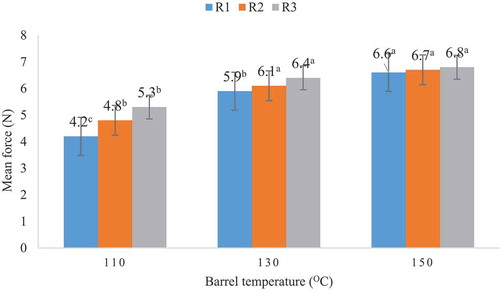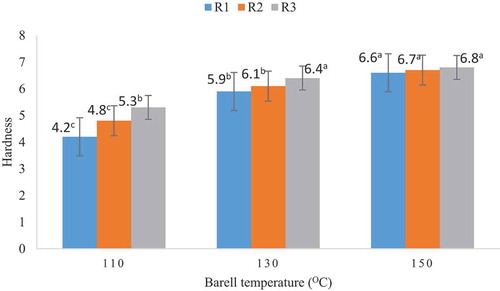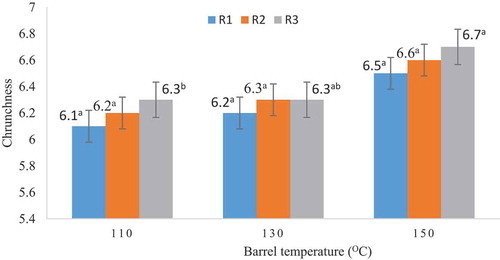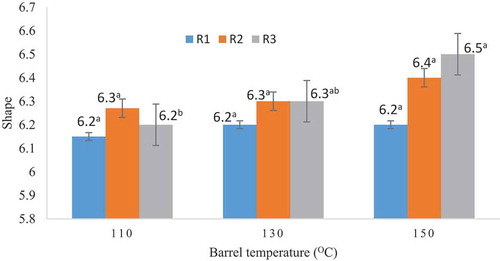 ?Mathematical formulae have been encoded as MathML and are displayed in this HTML version using MathJax in order to improve their display. Uncheck the box to turn MathJax off. This feature requires Javascript. Click on a formula to zoom.
?Mathematical formulae have been encoded as MathML and are displayed in this HTML version using MathJax in order to improve their display. Uncheck the box to turn MathJax off. This feature requires Javascript. Click on a formula to zoom.Abstract
Cassava is one of the most important food crops in Uganda. Despite its potential for processing into various value-added shelf-stable products, there are limited processed cassava products on the Ugandan market. Extrusion cooking is one of the technologies that provides several options for production of value-added products from cassava. This study aimed at evaluating the effects of processing conditions on the sensory and physical properties of cassava-based extruded snacks. Two factors namely; barrel temperature; 110°C, 130°C, and 150°C and cassava-maize flour ration; 60:40, 50:50, and 40:60 were investigated. The effect of these factors on the diameter, expansion ratio and sensory properties of the cassava-based extrudates was evaluated using standard methods. The study findings indicated an increase in the expansion ratio of the extrudates with increase in barrel temperature and amount of maize added. The results also indicated that the mean force required to puncture extruded sample reduced with increase in barrel temperature. Sensory evaluation results showed that the degree of liking for hardness of the extruded snacks was high for products produced at high barrel temperature and high maize flour rations. Findings from this study indicated that the best cassava-based extrudates were obtained at a barrel temperature of 150°C and at a mixing ratio of 40 parts of cassava to 60 parts of maize flour. The study highlighted the need to maximize other processing parameters like extruder screw speed, feed rate and the moisture content of the feed in order to get a more appealing product.
PUBLIC INTEREST STATEMENT
Cassava is one of the important foods in Uganda. However, there has been limited effort in processing cassava in various high value-added products on the Ugandan market. Limited number of cassava-based high value-added products on the Ugandan market is partly due to lack of processing technologies to produce such products. Utilization of cooking and shaping technologies will deliver various high value-added cassava-based products on the Ugandan market. This will therefore increase cassava utilization in Uganda.
1. Introduction
Cassava (Manihot esculenta) is one of the mostly consumed diets in Uganda and other parts of the world. According to Odongo and Etany (Citation2018); Roothaert and Magado (Citation2011), cassava production in Uganda ranks second after plantain. Currently, cassava is one of the most important food crops in Uganda given its resistance to drought, diseases and its high yielding potential (Nakabonge, Samukoya, & Baguma, Citation2017; Odongo & Etany, Citation2018). Cassava production is most practiced in regions of Uganda where it is a staple food or a hunger strategic crop (Odongo & Etany, Citation2018). According to MAFAP (Citation2013), cassava is considered a poor man’s crop and is predominantly grown by subsistence farmers as a staple crop on plots averaging from 1 to 3 acres with an estimated 60% and 40% of the production destined for household consumption and marketing, respectively. Cassava plays an important role in the national diet and contributes a substantial proportion to the caloric requirements of the population. Cassava is consumed in a number of forms, the most popular is cassava cake also known as “kalo” (Balagopalan, Citation2017). The other forms in which cassava is consumed are; root slices, root chips, baked root, pan fried grated root and steamed whole root. More research has been undertaken to increase the usage of cassava in the food industry and it is currently used in the brewing industry and bakery industry where various products have been developed (Falade & Akingbala, Citation2010). The snack industry is one of the fastest growing food sectors and is an important contributor within the global convenience food market. Nowadays, snacks and convenience foods are also consumed regularly in Uganda. Properly designed convenience foods can make an important contribution to nutrition in societies where social changes are altering traditional patterns of food preparation (Ajita, Citation2018; Tiwari & Jha, Citation2017). Extrusion cooking as a popular means of preparing snack foods based on cereals, tubers, and plant protein foodstuffs has elicited considerable interest and attention over the past 30 years (Ajita, Citation2018; Tiwari & Jha, Citation2017). With the emerging new technologies like extrusion cooking, there is increased interest in the use of cassava in the production of snacks. Therefore, this study aimed at optimizing processing conditions for cassava-based snacks.
2. Methodology
2.1. Procurement of materials
Maize (Zea mays) and Cassava (Manihot esculenta) flours that were used in the formulations were purchased from retail shops in Kampala Central business district and taken to the food processing laboratory at the Department of Food Technology and Nutrition, Makerere University for further processing.
2.2. Research design
Two factors were investigated each at three levels. The factors that were investigated are barrel temperatures, and cassava–maize flour ratio. The barrel temperatures, and cassava–maize flour ratio were each varied as shown in Table . Barrel temperatures were selected according to Moscicki and van Zuilichem (Citation2011) who reported the temperatures below as recommended for extrusion of cassava-based products. The flour mixture from each cassava-maize ratio was processed at each of the barrel temperatures (Table ). Cassava-maize ratios used in this study were selected basing on cassava consuming communities in Uganda that use similar ratios that were used in this study.
Table 1. Independent variable combinations that were used to produce different extruded product samples
2.3. Processing of cassava pops
High-quality cassava flour in ratios of (60%, 50%, and 40%) was mixed with de-hulled good quality maize flour (40%, 50%, and 60%) to make composite flour through thorough mixing using an electronic low-speed mixer. Water was added to the composite flour during mixing to attain a moisture content of 17% (7% of the total weight of the composite flour). The barrel temperature, screw speed, cutter speed and pressure of the twin screw extruder were then set. The main motor frequency, cutter speed, feeding frequency, moisture content of the feed and extrusion temperature in the 1st and 2nd zones were fixed at 26.1 rpm, 30.34 rpm, 36.1 kg/hr, 17%, 50°C and 90°C, respectively. The barrel temperatures were varied at 100°C, 130°C, and 150°C and cassava-maize mixing ratios were set at 60:40, 50:50, and 40:60.
The composite flour was then put in the feeder and the feeder frequency of 36.1 was used. The flour was allowed to run through the twin screw extruder after which the finished products were collected and dried at 45°C in a drier.
2.3.1. Determination of moisture content and expansion ratio of the cassava-based snack
Moisture content of the extrudates was determined by oven method following procedure described by Kim, Jin, and Ryu (Citation2012). Expansion ratio of the cassava-based snack was determined according to the methods described by Ahmed, Amir, and Gamal (Citation2017). Sample products were extruded as pieces of different length from the extruder. The diameter of the extrudates was measured using a Neiko Tools Digital vanier caliper having 0.05 mm accuracy. Oval extrudate samples were chosen and a minimum of 10 values of extrudate diameter were determined and a mean value of diameter measurements for each experimental run recorded. The diameter of the extruder die was 3.10 mm. Therefore, the expansion ratio was calculated as the square diameter of the extrudate divided by the square diameter of the die as shown in Equation (1).
where De is the diameter of the extrudate, Dd is the diameter of the die.
2.3.2. Determination of texture of the cassava-based snacks
2.3.2.1. Instrumental analysis
The texture of the extruded snacks was analyzed using a stable microsystems texture analyzer (Model-TA.XT Plus 42,095 Vienna court, Lammas road, Godalming surrey GU7, 1YL, UK). The extruded sample was placed on the platform transversally over a metal sheet support and operated in compression mode with a 6 mm probe. The texturometer head moved the probe down until it broke the extrudates. The force required to break the extrudate was then recorded.
2.3.2.2. Descriptive analysis of texture
The texture of the extruded snacks was described using the attributes of hardness, crunchiness, and chewiness. These are the most used descriptors in studies evaluating the texture of extruded snacks.
2.4. Sensory evaluation
The extruded cassava-based snacks produced under varying parameters were subjected to a sensory evaluation test to test their acceptability using a 9-point Hedonic scale. Sensory attributes of hardness, crunchiness, and shape were evaluated by a non-trained panel consisting of 30 people from the School of Food Technology, Nutrition and Bio-Engineering.
2.5. Statistical analysis
All experimental determinations were carried out in triplicate and subjected to statistical analysis of variance (ANOVA) using XLSTAT software version 2018 (Addinsoft, New York, NY, USA) to determine variation between means of cassava-maize snacks for their, sensory, physical properties. Significance variations were accepted at p < 0.05. Comparisons between means were done using the Fisher’s LSD test.
3. Results and discussion
3.1. Diameter of the cassava-based extrudates
The results for the diameter of the cassava-based snacks are summarized in Figure . The findings indicate that the diameter of extrudates increased with increase in temperature at all the cassava/maize mixing ratios. This may be because increasing barrel temperature could increase the degree of gelatinization and also the extent of superheated steam that causes the snack to expand more (Korkerd, Wanlapa, Puttanlek, Uttapap, & Rungsardthong, Citation2016; Sue, Sulaiman, Sanny, & Hanani, Citation2015). Temperature determines the vapor pressure of the moisture and thus degree of puffing. At a mixing ratio of 60 parts of cassava to 40 parts of maize flour, the diameter increased from 17.6 mm to19.38 mm (at 130°C) and 20.01 mm (150°C). A similar trend was observed when maize flour was increased from 40 to 60 parts. The highest diameter (21.29 mm) was recorded in extrudates with a high maize ration (60 parts) processed at the highest (150°C) barrel temperature. This is probably due to the stretching of the molecules at higher temperature which causes higher degree of gelatinization Guha and Ali (Citation2006). Low moisture conditions and an increase in barrel temperature lead to increased expansion (Leonel, Freitas, & Mischan, Citation2009).
4. Expansion ratio of the cassava-based extrudates
The results for expansion ratio of the cassava-based extrudates are indicated in Figure . The study findings indicate that the expansion ratio increased with increase in barrel temperature and amount of maize added. At a mixing ratio of 60 parts of cassava to 40 parts of maize flour, the expansion ratio increased from 31.226 mm (110°C) to 41.66 mm (150°C). A similar trend was observed when maize flour was increased from 40 to 50 and 60 parts with the highest expansion ratio (47.252) observed at a barrel temperature of 150°C and a maize ratio of 60 parts.
Figure 2. Effect of Barrel temperature and cassava maize mixing ratios (R1, R2 & R3) on the expansion ratio of cassava-based extrudates.

According to Gui, Gil, and Ryu (Citation2012), extrudate expansion was caused by transformation of biopolymer structure, nucleation, swelling of extrudate, bubble growth in the melt and bubble collapse. The expansion occurring in a food material depends on the pressure differential between the die and atmosphere. The high pressure close to the discharge of the die is reduced when the product leaves the extruder, causing flash evaporation of water and expansion of the product (Mesquita, Leonel, & Mischan, Citation2013). Generally, a greater expansion ratio is more desired in puffed snack foods as this typically indicates a lighter, crisper product (Maskus & Arntfield, Citation2015). The extrudates with high maize flour ratio expanded more than the others probably due to many starch granules as a result of high starch content.
4.1. Texture of the cassava-based extruded snack
The texture of the cassava extrudates is summarized in Figure . The results indicate that the mean force required to puncture the extruded sample reduced with increase in barrel temperature. According to the results shown in Figure , the mean force required to penetrate the cassava-based extrudates ranged from 19.76 N to 35.95 N with the highest force recorded at the highest cassava ration (60 parts) and the barrel temperature of 110°C. The high puncture force associated with low extrusion temperatures is due to the fact that a proportion of the starch is not completely gelatinized resulting in a dense and hard product.
4.2. Sensory evaluation
Consumer acceptance of extruded foods is mainly due to the convenience, value, attractive appearance and texture found to be particular for these foods, especially when it concerns snack products (Mesquita et al., Citation2013).
4.2.1. Hardness
Results in Figure shows that the degree of liking for hardness of the extruded snack was high for products produced at high barrel temperature and high maize flour rations with the scores ranging from 4.18 to 6.9. The panelists therefore liked soft and less hard products since results from the instrumental determination of hardness using a texture analyzer showed that hardness reduced with increase in barrel temperature.
4.2.2. Crunchness
The scores for product crunchiness are shown in Figure . The results indicate that the degree of liking crunchness ranged from 6.2 to 6.7. There was no significant difference (P > 0.05) in the crunchiness of the extruded products produced at different barrel temperatures and maize: cassava ratios. However, the score was high (6.7) at barrel temperatures of 150°C (Figure ). This was probably because products obtained with high temperatures and short extrusion process times normally present a porous, open structure, what confers to them a “crunchy” texture (Ramachandra & Thejaswini, Citation2015).
4.2.3. Shape
Figure shows that scores for shape were high for extrudates at high barrel temperatures and high maize flour ration with the highest score (6.5) recorded at a barrel temperature of 150°C and maize ratio of 60 parts. Samples that were extruded at lower barrel temperature (110°C) and high cassava flour ratio (60 parts) were scored lowest for shape. This implies that samples that had expanded more had a more appealing shape than those that had a low expansion.
5. Conclusion
Barrel temperature of the extruder had an effect on both the physical properties and sensory acceptability of the cassava-based snacks. More expansion of the extrudates was observed with increase in barrel temperature. The hardness of the extrudates reduced with increasing barrel temperatures. Extrudates produced at high barrel temperature were ranked high in terms of the different sensory attributes of hardness, crunchiness, and shape. The cassava-maize ratio affected both the physical properties and sensory acceptability of cassava-based snacks. High maize ratios resulted into increased expansion and reduced hardness of the extrudates. Extrudates in which a high maize ratio was used were ranked high in terms of the different sensory attributes (shape, hardness, and crunchiness). Findings from this study show that the best cassava-based extrudates are obtained at a barrel temperature of 150°C and at a mixing ratio of 40 parts of cassava to 60 parts of maize flour.
Acknowledgements
The authors are grateful to the technical assistance offered by the laboratory team at the School of Food Technology, Nutrition and Bioengineering, Makerere University and the volunteers that participated in the sensory evaluation study.
Disclosure statement
No potential conflict of interest was reported by the author.
Additional information
Funding
References
- Ahmed, R. M. A., Amir, A. I., & Gamal, H. R. (2017). Production of some snack foods by extrusion processing of some cereals and their by-products. American Journal of Food Technology, 12, 66–8.
- Ajita, T. (2018). Extrusion cooking technology: An advance skill for manufacturing of extrudate food products. In Extrusion of metals, polymers and food products. InTech.
- Balagopalan, C. (2017). Cassava utilization in food, feed and industry (pp. 301-318). Cassava: Biology, production and utilization.
- Falade, K. O., & Akingbala, J. O. (2010). Utilization of cassava for food. Food Reviews International, 27(1), 51–83. doi:10.1080/87559129.2010.518296
- Guha, M., & Ali, S. Z. (2006). Extrusion cooking of rice: Effect of amylase content and barrel temperature on product profile. Journal of Food Processing and Preservation, 30, 706–716. doi:10.1111/j.1745-4549.2006.00099.x
- Gui, Y., Gil, S. K., & Ryu, G. H. (2012). Effects of extrusion conditions on the physicochemical properties of extruded red ginseng. Preventive Nutrition and Food Science, 17(3), 203. doi:10.3746/pnf.2012.17.3.203
- Kim, C. H., Jin, T., & Ryu, G. H. (2012). Effects of moisture content on physical properties of extruded cereal flours. Journal of the Korean Society of Food Science and Nutrition, 41(11), 1603–1610. doi:10.3746/jkfn.2012.41.11.1603
- Korkerd, S., Wanlapa, S., Puttanlek, C., Uttapap, D., & Rungsardthong, V. (2016). Expansion and functional properties of extruded snacks enriched with nutrition sources from food processing by-products. Journal of Food Science and Technology, 53(1), 561–570. doi:10.1007/s13197-015-2039-1
- Leonel, M., Freitas, T. S., & Mischan, M. M. (2009). Physical characteristics of extruded cassava starch. Scientia Agricola, 66(4), 486–493. doi:10.1590/S0103-90162009000400009
- MAFAP. (2013). Review of food and agricultural policies in Uganda. MAFAP Country Report Series, FAO, Rome, Italy.
- Maskus, H., & Arntfield, S. (2015). Extrusion processing and evaluation of an expanded, puffed pea snack product. Journal of Nutrition & Food Sciences, 5(4), 1.
- Mesquita, C. D. B., Leonel, M., & Mischan, M. M. (2013). Effects of processing on physical properties of extruded snacks with blends of sour cassava starch and flaxseed flour. Food Science and Technology, 33(3), 404–410. doi:10.1590/S0101-20612013005000073
- Moscicki, L., & van Zuilichem, D. J. (2011). Extrusion-cooking and related technique. In Extrusion-cooking techniques: Applications, theory and sustainability (pp. 1–24). Wiley, Weinheim.
- Nakabonge, G., Samukoya, C., & Baguma, Y. (2017). Local varieties of cassava: Conservation, cultivation and use in Uganda. Environment, Development and Sustainability, 20, 1–19.
- Odongo, W., & Etany, S. (2018). Value chain and marketing margins of cassava: An assessment of cassava marketing in northern Uganda. African Journal of Food, Agriculture, Nutrition and Development, 18(1). doi:10.18697/ajfand.81.15955
- Ramachandra, H. G., & Thejaswini, M. L. (2015). Extrusion technology: A novel method of food processing. International Journal of Innovative Science, Engineering & Technology, 2(4), 358–369.
- Roothaert, R. L., & Magado, R. (2011). Revival of cassava production in Nakasongola District, Uganda. International Journal of Agricultural Sustainability, 9(1), 76–81. doi:10.3763/ijas.2010.0547
- Sue, S. L., Sulaiman, R., Sanny, M., & Hanani, Z. A. (2015). Effect of extrusion barrel temperatures on residence time and physical properties of various flour extrudates. International Food Research Journal, 22, 3.
- Tiwari, A., & Jha, S. K. (2017). Extrusion cooking technology: Principal mechanism and effect on direct expanded snacks – An overview. International Journal of Food Studies, 6, 1.

